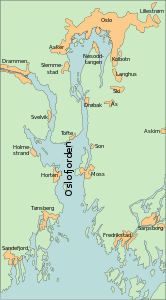Oslofjord
| Oslofjord | ||
|---|---|---|
|
Oslofjord, view from Holmenkollbakken |
||
| Waters | Skagerrak | |
| Land mass | Scandinavian peninsula | |
| Geographical location | 59 ° 19 ′ N , 10 ° 35 ′ E | |
|
|
||
| length | 118 km | |
| Greatest water depth | 300 m | |
| Tributaries | Glamma | |
|
Map of the Oslofjord |
||
The Oslofjord (in Norwegian Oslofjorden ) is a fjord in southern Norway ; it is one of the largest fjords in Norway and the region is the most densely populated in the whole country.
location
Stretched over a length of about 118 kilometers as the crow flies in a south-north direction, the Oslofjord forms the entrance to the country's capital, Oslo , which is located at the northern end of the fjord. In the south, the Oslofjord merges into the Skagerrak at Langesund . From a geological and tectonic point of view, it forms part of the Oslo Trench . It is up to 300 m deep and is considered to be the busiest waterway in the north. Since the Gulf Stream is too far away from the Skagerrak and thus the Oslofjord and therefore does not warm it enough, the Oslofjord is the only fjord in Norway that occasionally freezes over.
history
With its numerous natural harbors, tributaries such as Drsamefjord and Bunnefjord and branches, the region around the fjord offered favorable conditions for settlement as early as the Iron Age . Early traces of human settlement even go back to the Neolithic . In the transition between the time of the Vikings and the early Middle Ages, around 1000 AD, marketplaces and clusters of farms began to develop into cities. Since the sea level 1000 years ago was about 4 meters higher than it is today due to the uplift of the land in southern Scandinavia, many of these places are often a few kilometers from the current bank of the Oslofjord. Other cities such as Oslo and Tønsberg were only founded during this period for strategic military or commercial reasons.
In the Middle Ages, the Oslofjord, like the landscape on either side, was called Vik (in) or Fold (in) . Fold in the former Fylke name Østfold and Vestfold included. On April 9, 1940, the German heavy cruiser Blücher was sunk in the fjord by Norwegian artillery fire. This delayed the capture of Oslo by the Wehrmacht and enabled the Norwegian king to escape.
Today the region is the largest population center in Norway; About 40 percent of the country's population can reach the Oslofjord within an hour's drive. 40 percent of the jobs are also here.
traffic
The Oslofjord is therefore an important waterway with a high volume of cargo and passenger ships and at the same time very important for recreation on its banks and on the water.
The area around the fjord is therefore accessible by an extensive road network. On its east bank, Europastraße 6 runs along its entire length in the hinterland , on the west bank the main traffic axis is Europastraße 18 . Both roads meet at the north end of the fjord in Oslo.
Between Verpen in the Viken municipality of Hurum and Måna in the Viken municipality of Frogn , the two sides of the fjord are connected by the Oslofjord tunnel.
There are also two major ferry routes that connect the west bank and the east bank:
- Hoarding - Moss (Bastø Fosen)
- Sandefjord (N) - Strömstad (S) ( Color Line , Fjord Line )
In addition, important international daily ferry routes (passengers, vehicles) run through the Oslofjord:
- Oslo (N) - Kiel (D) (Color Line), ships: Color Fantasy , Color Magic
- Oslo (N) - Copenhagen (DK) ( DFDS ), ships: Crown Seaways , Pearl Seaways
- Oslo (N) - Frederikshavn (DK) ( Stena Line ), ship: Stena Saga
All major islands in the Oslofjord can be reached by local ferries.
The most important ports on the Oslofjord are, besides Oslo, Moss, Fredrikstad , Strömstad, Tønsberg , Sandefjord and Langesund .
There are railway lines on both the west and east sides of the fjord that meet in Oslo.
Islands in the Oslofjord
| Surname | Area in km² |
|---|---|
| Bastøy | 2.6 |
| Gressholmen | 0.05 |
| Hovedøya | 0.04 |
| Lindøya | 0.41 |
| Nakkholmen | 0.59 |
| Nøtterøy | 59 |
| Ormøya | 0.18 |
| Tjøme | 39 |




